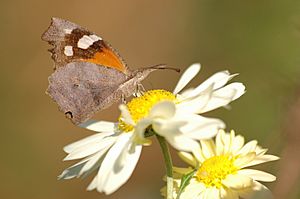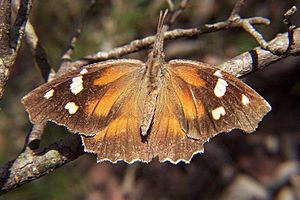American snout facts for kids
Quick facts for kids American snout |
|
|---|---|
 |
|
| Conservation status | |
| Scientific classification | |
| Synonyms | |
|
Libytheana bachmanii Kirtland, 1851 |
The American snout or common snout butterfly (Libytheana carinenta) is a special type of butterfly. It belongs to the Nymphalidae family, also known as brush-footed butterflies. You can find this butterfly in both North and South America. Its caterpillars eat plants from the Celtis family, like hackberry trees.
Contents
American Snout Butterfly
What Does It Look Like?
Snout butterflies have long mouthparts called labial palpi. These, along with their antennae, make their face look like the stem of a dead leaf. This amazing camouflage helps them hide. They often hang upside down under a twig, making them almost impossible to see. Their wings are black-brown with white and orange patterns. The front wings have a unique hooked tip.
What About Their Caterpillars?
The caterpillars of the American snout butterfly look a bit humpbacked. They have a small head and a rounded, tapered end. Their bodies are dark green with yellow stripes along the top and sides. They also have two black bumps on their upper body. These caterpillars love to eat the leaves of the common hackberry (Celtis occidentalis) tree.
Amazing Migrations
American snout butterflies are known for their incredible migrations. Sometimes, so many butterflies fly together that they can make the sky look dark! These large movements happen at different times. They often start in South Texas and move northward. Places like San Antonio, the Texas Hill Country, and Austin often see these huge groups.
Other migrations have been seen in Arizona, Kansas, and the Lake Erie Islands. These migrations usually happen from June through October. Scientists think they are triggered by dry periods followed by lots of summer rain. The dry weather can reduce tiny insects that would normally control the butterfly population. Then, the heavy rains help the spiny hackberry trees grow new leaves. These new leaves provide plenty of food for the caterpillars.
Also, dry spells can make the butterflies go into a kind of sleep. When the rains come, they all wake up at once to lay eggs. This leads to a sudden burst in their population. In Texas, big migrations were seen in 1921, 1978, 1996, 2018, and 2020.




